Are you curious about exploring the vibrant culinary landscape of Mexico and Latin America, perhaps even while seeking LGBTQ+ friendly experiences? A pupusa is a thick flatbread from El Salvador, usually stuffed with cheese, beans, and meat, and served with curtido and salsa. At gaymexico.net, we’re passionate about sharing the best of Mexico’s culture, so join us as we uncover the secrets of this fantastic dish and other culinary gems. If you are a member of the LGBTQ+ community looking for travel tips and cultural insights, we invite you to explore the diverse flavors and traditions that Mexico has to offer.
1. Unveiling the Pupusa: More Than Just Mexican Food
The pupusa is a delectable staple that is more than just “Mexican food”, but is actually a traditional dish from El Salvador. It’s a thick, handmade flatbread, typically made with masa harina (corn flour) or rice flour. The magic of a pupusa lies in its filling. Common stuffings include:
- Queso (Cheese): Often a soft, melty cheese like queso fresco or mozzarella.
- Frijoles Refritos (Refried Beans): Creamy and savory, providing a hearty element.
- Chicharrón (Pork Cracklings): Ground into a paste, adding a rich, pork flavor.
- Revuelta (Mixed): A combination of cheese, beans, and pork.
Once stuffed, the pupusa is grilled or pan-fried until golden brown and slightly crispy on the outside. It’s typically served with curtido, a tangy cabbage slaw, and salsa roja (red sauce).
2. The Alluring Appeal of Pupusas
What makes the pupusa so irresistible? Here’s a breakdown of its key attractions:
- Flavorful Combination: The savory filling, the slightly sweet masa, and the tangy curtido create a harmonious blend of flavors.
- Textural Delight: The crispy exterior gives way to a soft, chewy interior and a melty, flavorful filling.
- Customizable: With endless filling possibilities, there’s a pupusa for every palate.
- Affordable and Accessible: Pupusas are widely available and generally inexpensive, making them a great option for budget-conscious foodies.
- Cultural Significance: Eating a pupusa is a way to connect with the rich culinary traditions of El Salvador.
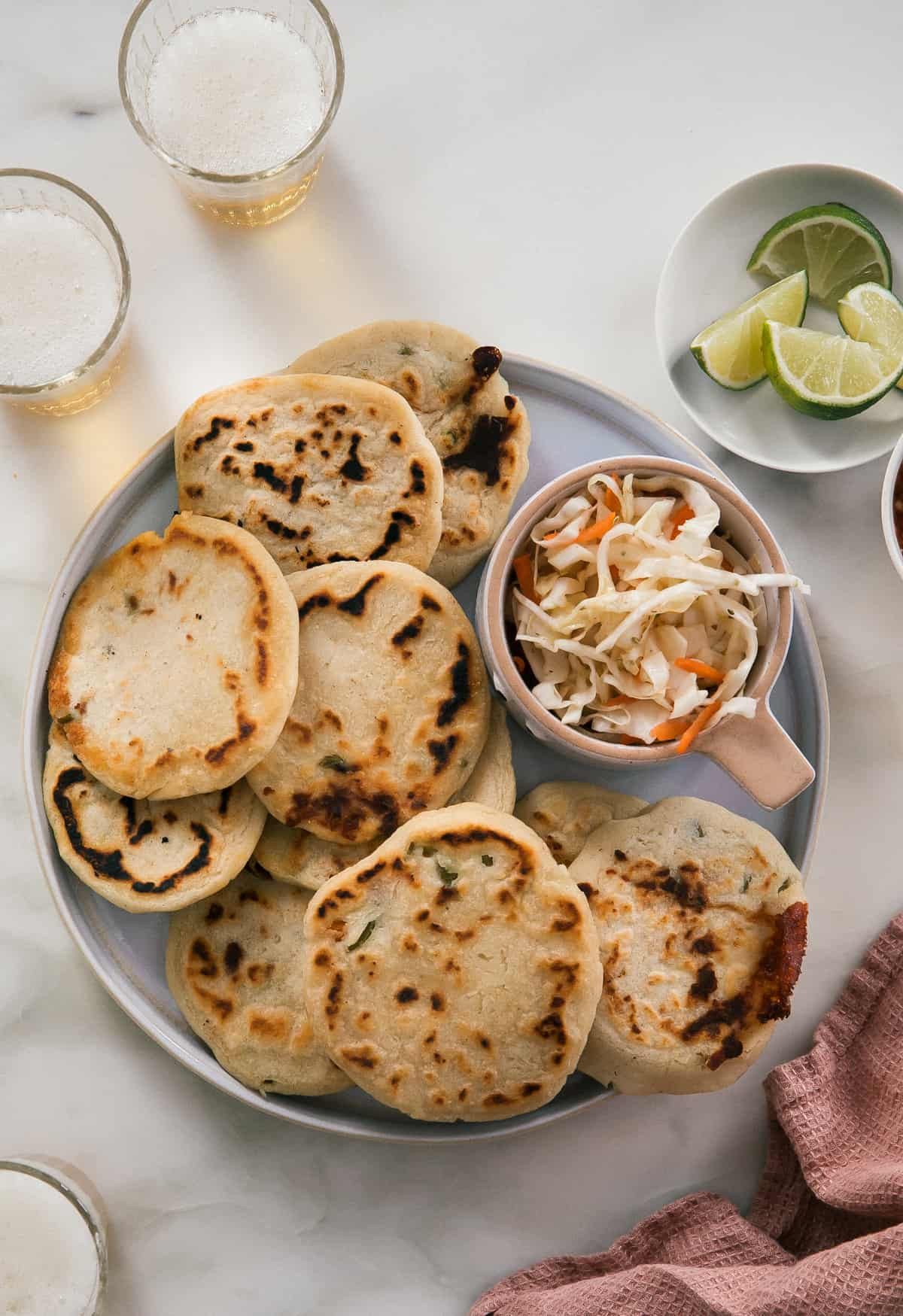 Pupusas on a round plate with curtido and limes
Pupusas on a round plate with curtido and limes
Pupusas are traditionally served with curtido, a cabbage slaw, and a side of lime.
3. Pupusas vs. Mexican Cuisine: Understanding the Differences
While pupusas are often mistaken for Mexican food, it’s important to recognize their distinct origins. Pupusas are the national dish of El Salvador and have their own unique preparation style and flavor profile.
Here’s a comparison to help distinguish them:
| Feature | Pupusas (El Salvador) | Common Mexican Street Foods |
|---|---|---|
| Origin | El Salvador | Mexico |
| Main Ingredient | Masa harina (corn flour) or rice flour | Corn or wheat tortillas |
| Preparation | Thick flatbread stuffed with fillings | Tortillas used as a base for various toppings |
| Common Fillings | Cheese, beans, pork, revuelta | Meats, vegetables, sauces |
| Typical Toppings | Curtido (cabbage slaw), salsa roja | Salsa, guacamole, onions, cilantro, lime |
| Serving Style | Served as a standalone dish | Can be served as tacos, quesadillas, etc. |
| Texture | Thick, soft, slightly crispy | Varies depending on the dish |
4. The Art of Making Pupusas: A Step-by-Step Guide
Making pupusas at home can be a rewarding experience. Here’s a simplified guide to get you started:
Ingredients:
- 2 cups masa harina
- 1 1/2 cups warm water
- 1 teaspoon salt
- Filling of your choice (cheese, beans, cooked pork, etc.)
- Oil for cooking
Instructions:
- Prepare the Dough: In a bowl, combine masa harina and salt. Gradually add warm water, mixing until a soft, pliable dough forms.
- Prepare the Fillings: Have your chosen fillings ready to go.
- Form the Pupusas: Take a handful of dough and form it into a ball. Create a well in the center and fill it with your desired filling.
- Seal the Pupusa: Gently close the dough around the filling, ensuring it’s completely sealed. Flatten the pupusa into a thick, round disc.
- Cook the Pupusas: Heat a lightly oiled griddle or pan over medium heat. Cook the pupusas for 5-7 minutes per side, or until golden brown and cooked through.
- Serve: Serve hot with curtido and salsa roja.
5. Curtido and Salsa Roja: The Perfect Pupusa Companions
No pupusa experience is complete without curtido and salsa roja. These toppings add essential flavors and textures to the dish.
- Curtido: This tangy cabbage slaw provides a refreshing counterpoint to the richness of the pupusa. It’s typically made with shredded cabbage, carrots, onions, vinegar, oregano, and salt.
- Salsa Roja: This red sauce adds a touch of heat and complexity. It’s usually made with tomatoes, onions, garlic, chili peppers, and spices.
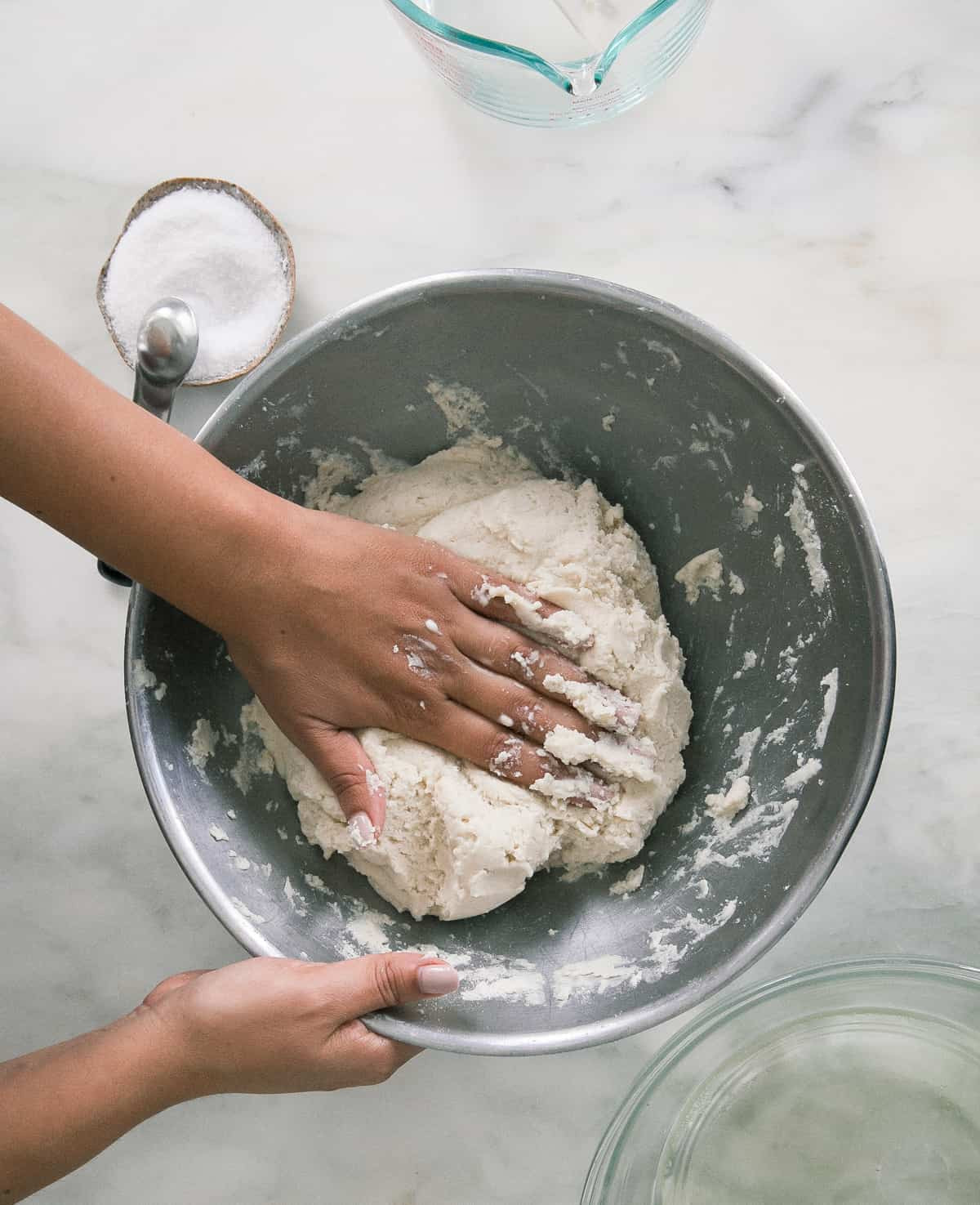 Pupusa dough being mixed
Pupusa dough being mixed
Mixing the masa harina with water to form the dough is a crucial step in making pupusas.
6. Exploring Pupusa Variations: A World of Flavors
The beauty of pupusas lies in their versatility. Here are some popular variations to explore:
- Pupusas de Queso: Filled with cheese only.
- Pupusas de Frijol con Queso: Filled with refried beans and cheese.
- Pupusas de Chicharrón: Filled with ground pork cracklings.
- Pupusas Revueltas: Filled with a mixture of cheese, beans, and pork.
- Pupusas de Ayote: Filled with squash.
- Pupusas de Loroco: Filled with loroco, an edible flower bud popular in El Salvador and Guatemala.
7. Where to Find Authentic Pupusas in Mexico and Beyond
While pupusas are originally from El Salvador, they can be found in some Mexican restaurants and Latin American eateries around the world. Here are some tips for finding authentic pupusas:
- Look for Salvadoran Restaurants: These restaurants are most likely to serve authentic pupusas.
- Check Latin American Markets: Some Latin American markets have food stalls or restaurants that specialize in pupusas.
- Ask Around: Get recommendations from friends, family, or online food communities.
- Explore Online Reviews: Check online reviews for restaurants that claim to serve pupusas.
8. Pupusas and the LGBTQ+ Community: A Welcoming Dish
Food is a universal language, and pupusas are a welcoming dish that can be enjoyed by everyone, including the LGBTQ+ community. Sharing a meal is a great way to connect with others and experience different cultures.
At gaymexico.net, we believe in creating inclusive spaces where everyone feels welcome and respected. We encourage you to explore the diverse culinary scene in Mexico and Latin America, and to try new dishes like pupusas with an open mind and an adventurous spirit.
9. Making Curtido: Quick Pickled Cabbage Slaw
Curtido, the tangy cabbage slaw served with pupusas, is a must. It’s easy to make and adds a refreshing element that balances the richness of the pupusa.
Ingredients:
- 1/2 head of cabbage, thinly shredded
- 1 carrot, grated
- 1/2 onion, thinly sliced
- 1/2 cup white vinegar
- 1/4 cup water
- 1 tablespoon dried oregano
- 1 teaspoon salt
- 1/2 teaspoon sugar (optional)
Instructions:
- In a large bowl, combine the cabbage, carrot, and onion.
- In a separate bowl, whisk together the vinegar, water, oregano, salt, and sugar (if using).
- Pour the vinegar mixture over the cabbage mixture and toss to combine.
- Let it sit for at least 30 minutes, or preferably longer, to allow the flavors to meld.
- Store in the refrigerator.
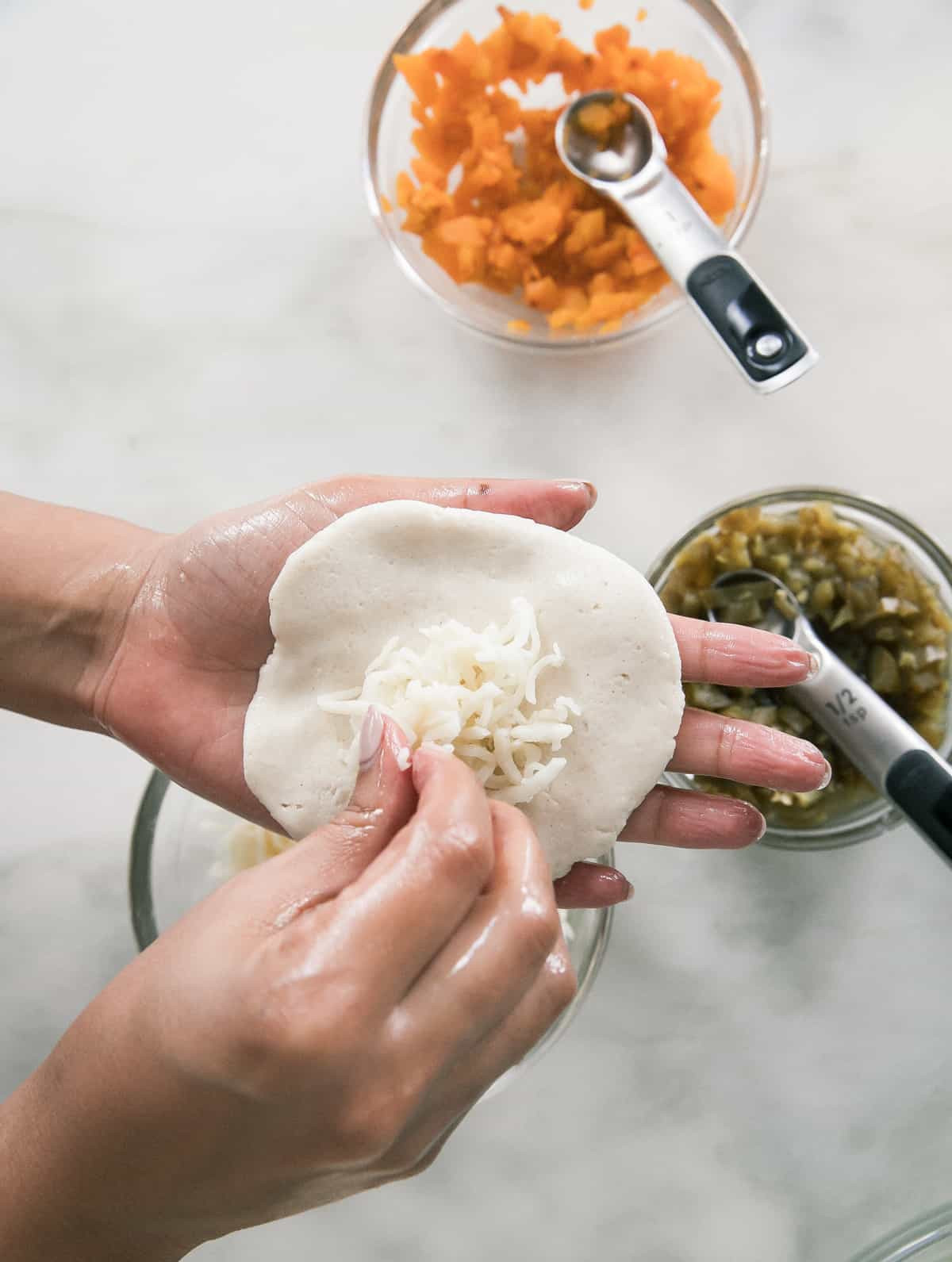 Pupusas being filled with cheese
Pupusas being filled with cheese
The filling is the heart of a pupusa. Cheese is a favorite, but the options are endless.
10. Salsa Roja: Adding a Spicy Kick
Salsa roja, the red sauce served with pupusas, adds a touch of heat and complexity. There are many variations of salsa roja, but here’s a basic recipe:
Ingredients:
- 4 Roma tomatoes
- 1/2 onion
- 2 cloves garlic
- 1-2 jalapeño peppers, depending on your spice preference
- 1/4 cup water
- 1 tablespoon olive oil
- Salt to taste
Instructions:
- Roast the tomatoes, onion, garlic, and jalapeño peppers on a baking sheet until softened and slightly charred.
- Let them cool slightly, then peel the tomatoes and remove the seeds from the jalapeño peppers (if desired).
- In a blender or food processor, combine the roasted vegetables, water, and olive oil.
- Blend until smooth.
- Season with salt to taste.
11. Braised Meats: A Hearty Pupusa Filling Option
Braised meats make a delicious and hearty pupusa filling. You can use pork shoulder, beef, or chicken.
Ingredients:
- 2 pounds pork shoulder, beef chuck, or chicken thighs
- 1 onion, chopped
- 2 cloves garlic, minced
- 1 teaspoon cumin
- 1 teaspoon chili powder
- 1/2 teaspoon oregano
- 1 cup chicken broth
- Salt and pepper to taste
Instructions:
- Season the meat with salt, pepper, cumin, chili powder, and oregano.
- In a large pot or Dutch oven, brown the meat on all sides.
- Add the onion and garlic and cook until softened.
- Pour in the chicken broth and bring to a simmer.
- Cover and cook for 2-3 hours, or until the meat is very tender.
- Shred the meat and use it as a filling for pupusas.
12. Pureed Beans: A Vegetarian Delight
Pureed beans make a creamy and flavorful vegetarian pupusa filling.
Ingredients:
- 1 tablespoon olive oil
- 1/2 onion, chopped
- 2 cloves garlic, minced
- 1 teaspoon cumin
- 1 (15-ounce) can black beans, pinto beans, or kidney beans, drained and rinsed
- 1/2 cup vegetable broth
- Salt and pepper to taste
Instructions:
- Heat the olive oil in a saucepan over medium heat.
- Add the onion and garlic and cook until softened.
- Add the cumin and cook for 1 minute more.
- Add the beans and vegetable broth and bring to a simmer.
- Reduce heat and simmer for 10 minutes, or until the beans are softened.
- Puree the beans with an immersion blender or in a regular blender until smooth.
- Season with salt and pepper to taste.
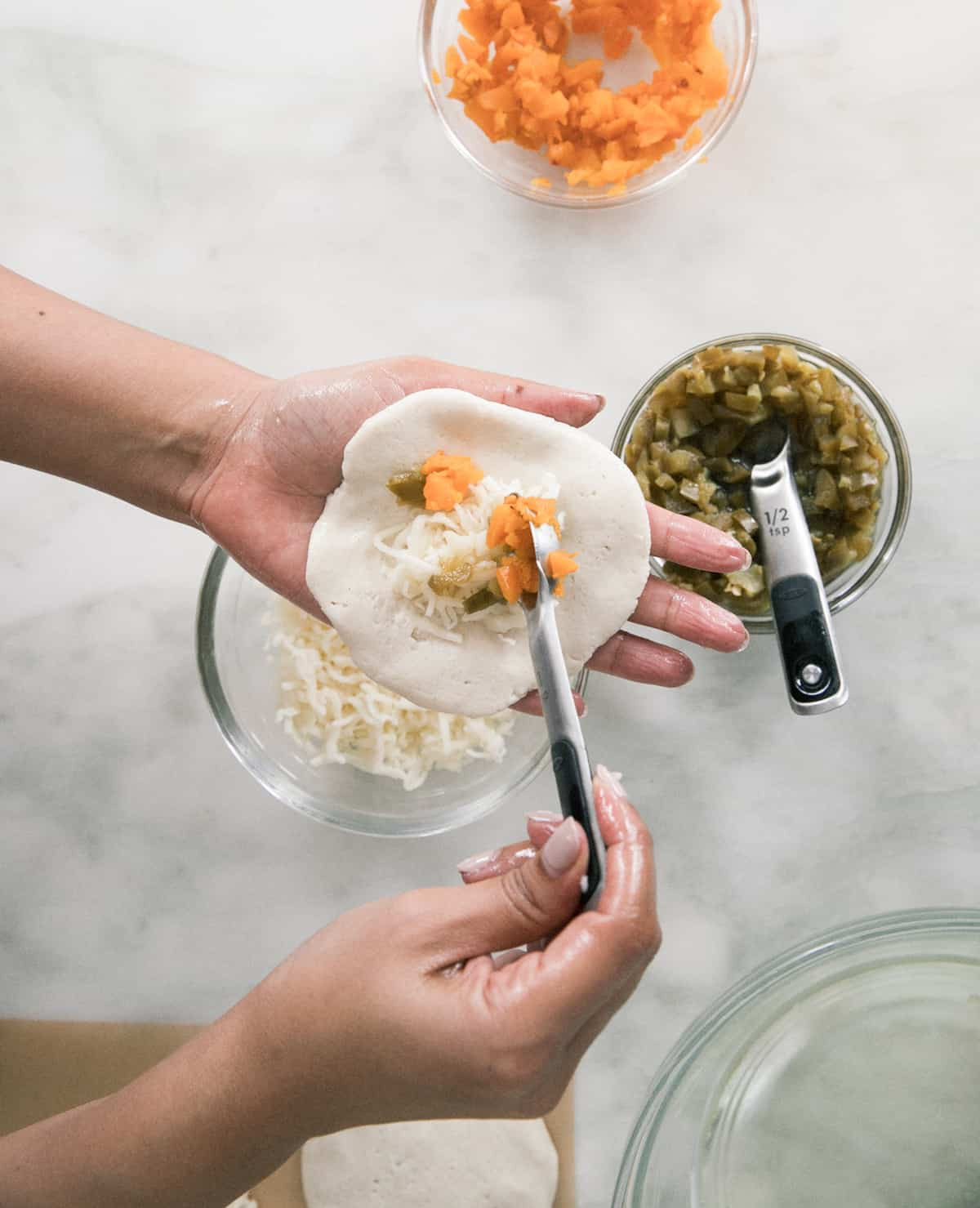 Pupusas being formed by hands
Pupusas being formed by hands
Forming the pupusas by hand takes practice, but it’s worth the effort for the delicious result.
13. Cheese Selection: Choosing the Right Melt
Cheese is a must-have pupusa filling. Here are some cheeses that melt well and add great flavor:
- Mozzarella: A classic choice for its melty texture.
- Oaxaca Cheese: A stringy, melty Mexican cheese.
- Queso Fresco: A fresh, crumbly cheese that softens when heated.
- Gouda: Adds a nutty, slightly sweet flavor.
- Taleggio: A pungent, creamy cheese.
- Sharp Cheddar Cheese: Adds a sharp, tangy flavor.
- Fontina: A smooth, nutty cheese.
14. The Importance of Masa Harina
Masa harina is the key ingredient in pupusas. It’s a finely ground corn flour that has been treated with an alkaline solution, which gives it a unique flavor and texture.
When buying masa harina, look for a brand that is specifically labeled for making tortillas or pupusas. Maseca is a popular and widely available brand.
15. Vegan Pupusas: A Plant-Based Delight
Pupusas can easily be made vegan by using plant-based fillings and toppings.
Here are some vegan pupusa filling ideas:
- Refried beans
- Roasted vegetables (squash, zucchini, cauliflower)
- Vegan cheese
- Vegan chorizo
- Lentils
For curtido, make sure to use a vegan vinegar. For salsa roja, simply omit any animal-based ingredients.
16. Gluten-Free Pupusas: A Safe and Tasty Option
Pupusas made with masa harina are naturally gluten-free. However, it’s important to make sure that your masa harina is not contaminated with gluten. Look for a brand that is certified gluten-free.
Also, be mindful of the fillings and toppings you use. Some fillings, such as braised meats, may contain gluten-containing ingredients.
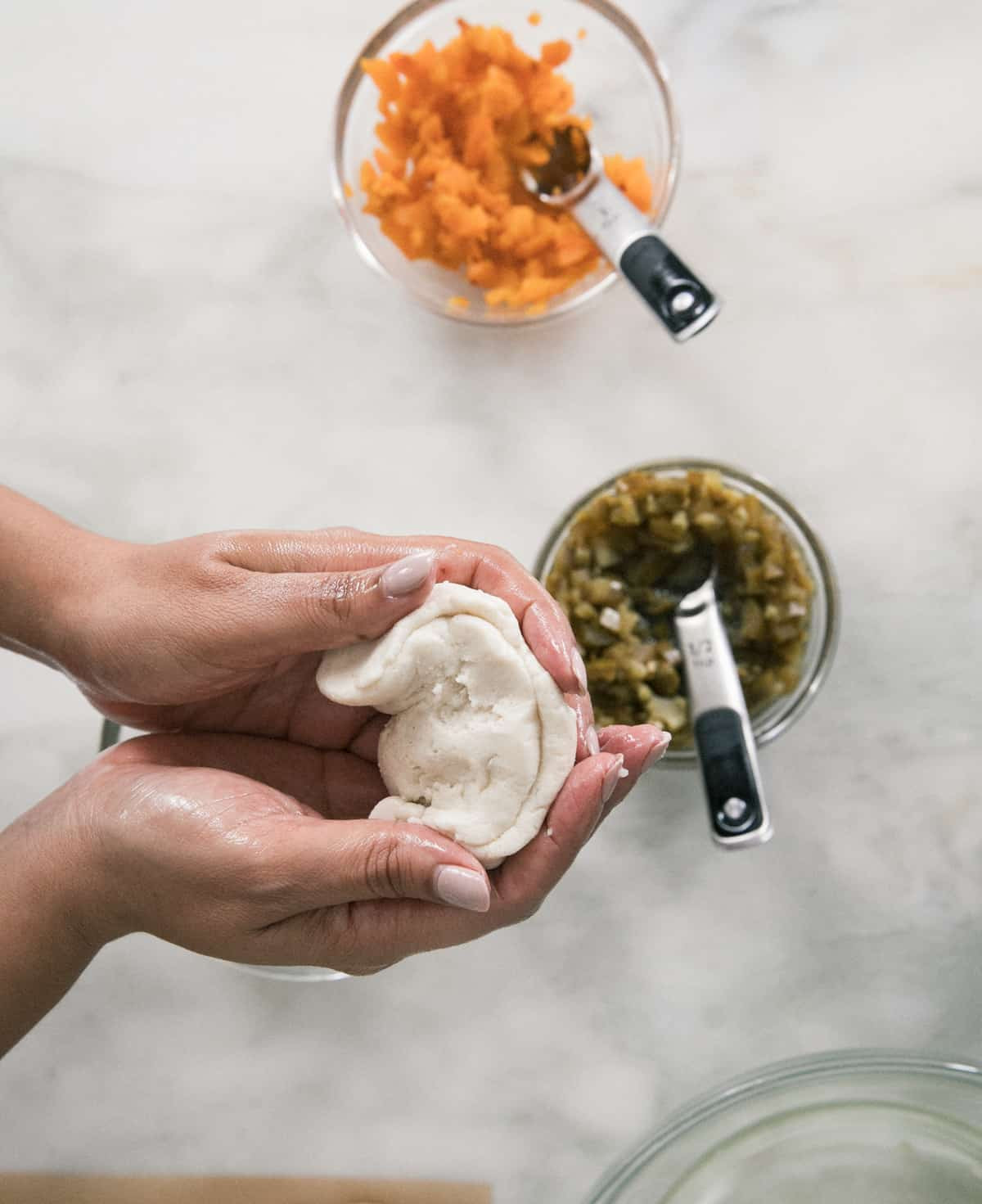 Pupusas being formed by hands
Pupusas being formed by hands
Sealing the pupusa properly ensures that the filling stays inside while cooking.
17. Step-by-Step Pupusa Assembly
Here’s a detailed step-by-step guide to assembling pupusas:
- Prepare the Dough: Make sure your masa harina dough is soft and pliable.
- Divide the Dough: Divide the dough into equal-sized balls. The size will depend on how big you want your pupusas to be.
- Flatten the Dough: Flatten each ball of dough into a thick disc, about 1/4-inch thick.
- Add the Filling: Place a spoonful or two of your desired filling in the center of the disc.
- Seal the Pupusa: Bring the edges of the dough up and over the filling, pinching them together to seal the pupusa completely.
- Flatten Again: Gently flatten the pupusa again, making sure it’s still sealed.
- Cook: Cook the pupusas on a lightly oiled griddle or pan over medium heat until golden brown and cooked through.
18. Cooking Pupusas: Achieving the Perfect Texture
The key to cooking pupusas is to achieve a crispy exterior and a soft, cooked-through interior.
Here are some tips for cooking pupusas:
- Use a hot griddle or pan: Make sure your griddle or pan is hot before adding the pupusas. This will help them to get crispy on the outside.
- Cook over medium heat: Cooking the pupusas over medium heat will allow them to cook through without burning on the outside.
- Don’t overcrowd the pan: Cook the pupusas in batches to avoid overcrowding the pan. Overcrowding the pan will lower the temperature and prevent the pupusas from getting crispy.
- Flip carefully: Flip the pupusas carefully to avoid breaking them.
- Cook until golden brown: Cook the pupusas until they are golden brown and cooked through.
19. Freezing Pupusas: A Convenient Option
Pupusas can be frozen for later use. Here’s how to freeze them:
- Assemble the Pupusas: Assemble the pupusas as directed.
- Place on a Baking Sheet: Place the assembled pupusas on a baking sheet lined with parchment paper.
- Freeze: Freeze the pupusas for at least 2 hours, or until they are solid.
- Transfer to a Freezer Bag: Transfer the frozen pupusas to a freezer bag.
- Store: Store the pupusas in the freezer for up to 3 months.
To cook frozen pupusas, simply cook them on a lightly oiled griddle or pan over medium heat until golden brown and cooked through. You may need to cook them for a few minutes longer than fresh pupusas.
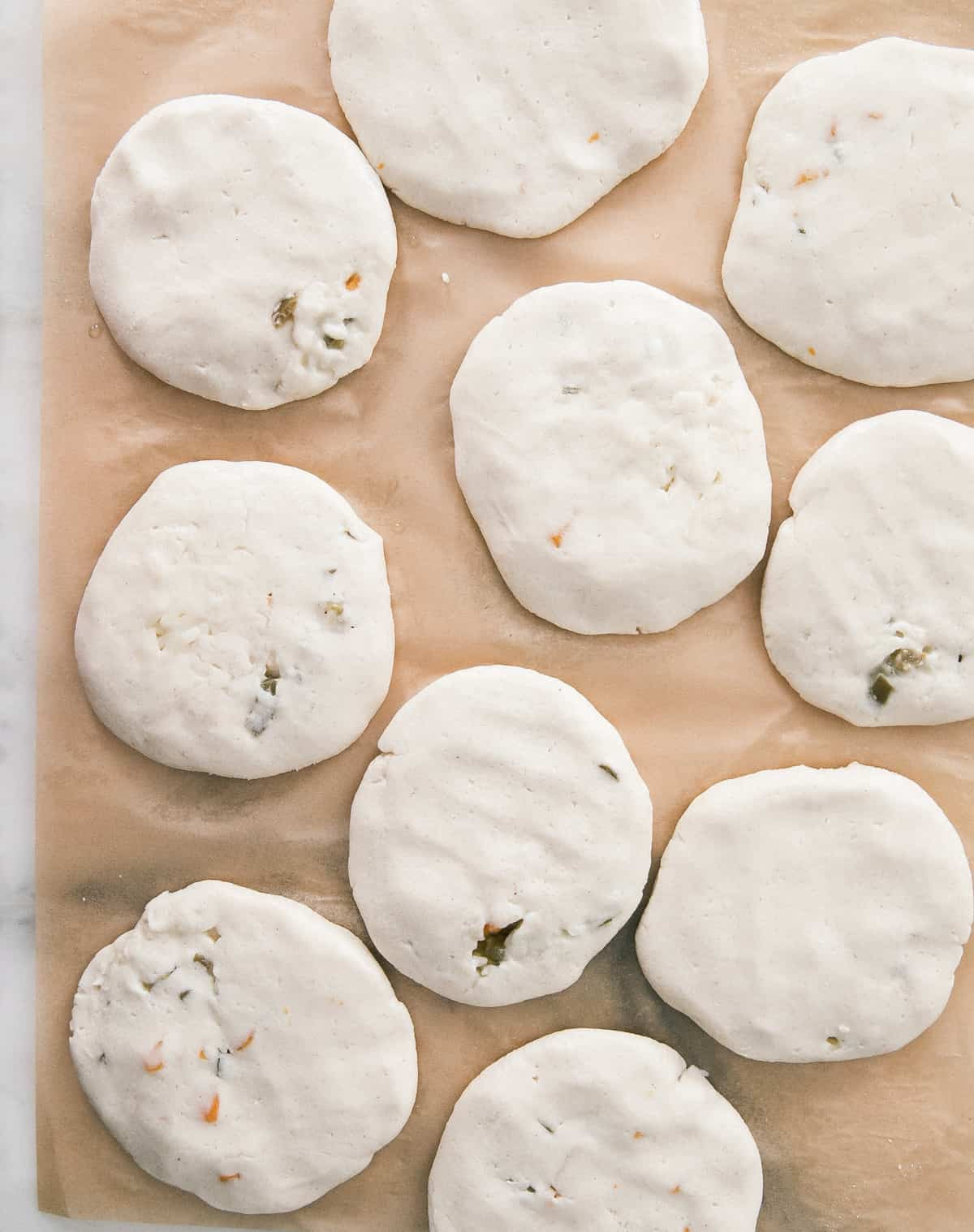 Formed uncooked pupusas on a piece of parchment
Formed uncooked pupusas on a piece of parchment
Uncooked pupusas can be frozen for a quick and easy meal later.
20. Tamale Masa vs. Pupusa Masa: Understanding the Difference
Tamale masa and pupusa masa are both made from masa harina, but they have different ingredients and textures.
Tamale masa typically contains lard or shortening, which gives it a richer flavor and a more tender texture. Pupusa masa does not contain lard or shortening, which makes it slightly chewier.
While you can use tamale masa to make pupusas, the texture will be different. It’s best to use masa harina specifically labeled for making pupusas.
21. Pupusas: A Culinary Journey Through El Salvador
Pupusas are more than just a food; they’re a symbol of El Salvadorian culture and heritage. Each bite tells a story of tradition, family, and community.
22. A Message to the LGBTQ+ Community: Embrace Diversity
At gaymexico.net, we celebrate diversity and inclusion. We encourage you to embrace the richness of different cultures and to try new things with an open mind. Whether you’re exploring the vibrant nightlife of Puerto Vallarta or savoring the delicious flavors of Mexican cuisine, we want you to feel welcome and safe.
Mexico has a rich history and culture, and it’s important to learn about and respect the traditions of the people who live there. We hope you’ll join us in celebrating the beauty and diversity of Mexico.
23. Tips and Tricks for Perfect Pupusas
Here are some additional tips and tricks for making perfect pupusas:
- Use a cookie scoop: Use a cookie scoop to divide the dough into equal-sized balls. This will help to ensure that your pupusas are uniform in size.
- Keep your hands oiled: Masa harina dough is sticky, so it’s important to keep your hands oiled. This will prevent the dough from sticking to your hands and make it easier to work with.
- Pinch tears: If a tear appears in the dough while you’re forming the pupusas, simply pinch the masa shut.
- Use gravity: When you move the ball of masa from palm to palm, gravity will help it to get a bit flatter.
- Place on parchment: Place the formed pupusas on a piece of parchment paper to prevent them from sticking to the plate or cutting board.
- Keep warm in the oven: If you don’t own a large griddle, you can keep the cooked pupusas warm in the oven while you’re working your way through cooking them. Place a cooling rack on top of a baking sheet and stick it in a 200-degree F oven.
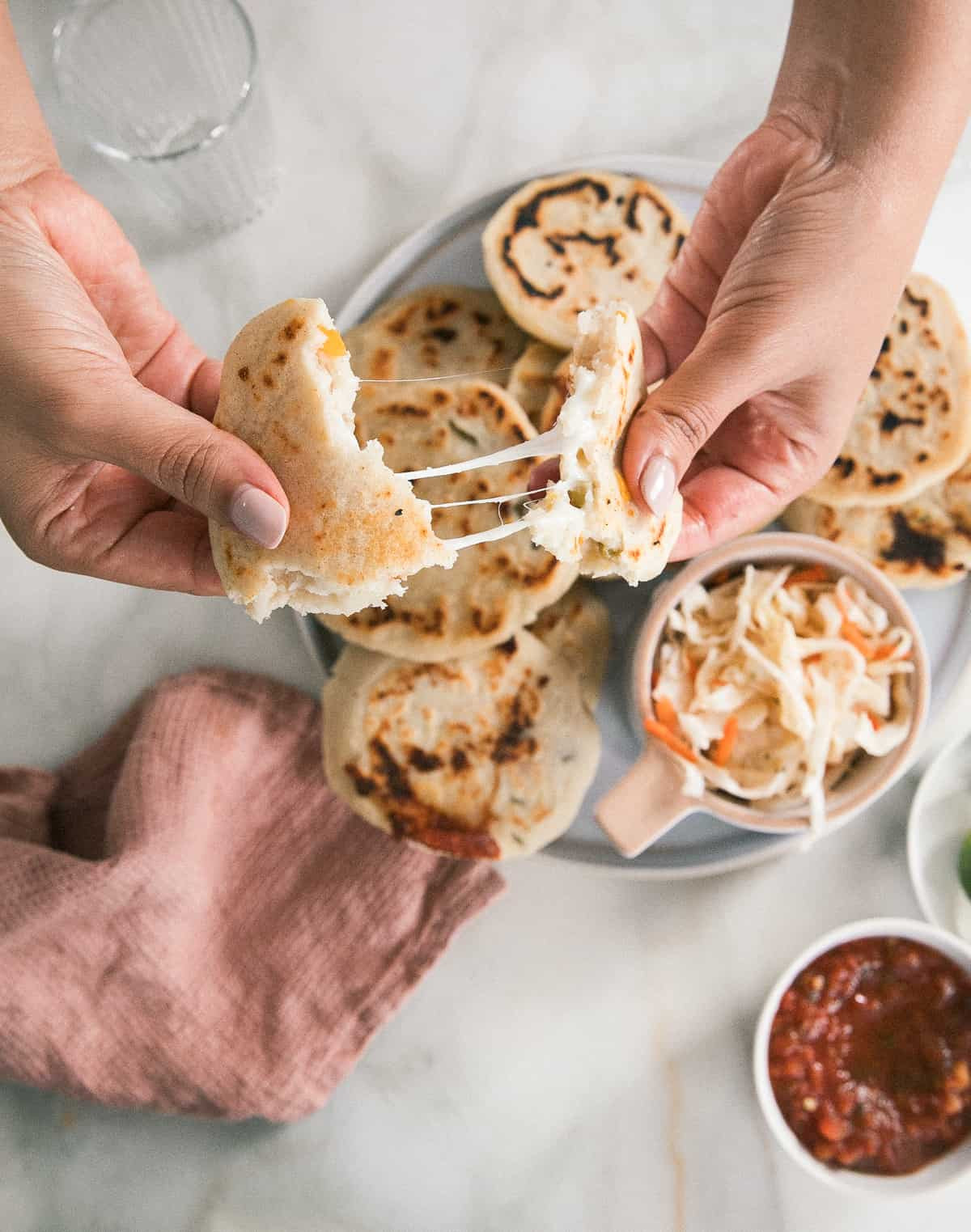 Pupusa being torn apart with cheese pull
Pupusa being torn apart with cheese pull
The cheese pull is a sign of a perfectly cooked, cheesy pupusa.
24. Are Pupusas Healthy? A Nutritional Overview
Pupusas can be a part of a healthy diet, but it’s important to be mindful of the ingredients and portion sizes.
Here’s a nutritional overview of pupusas:
- Carbohydrates: Pupusas are a good source of carbohydrates, which provide energy for the body.
- Protein: The fillings in pupusas, such as beans and cheese, provide protein, which is essential for building and repairing tissues.
- Fat: Pupusas can be high in fat, especially if they are filled with cheese or pork.
- Fiber: Pupusas made with masa harina provide fiber, which aids in digestion and helps to regulate blood sugar levels.
- Vitamins and Minerals: Pupusas can be a good source of vitamins and minerals, depending on the fillings and toppings.
To make pupusas healthier, choose lean fillings, such as beans or roasted vegetables. Use a minimal amount of oil when cooking the pupusas. And top them with healthy toppings, such as curtido and salsa.
25. Pupusas Around the World: Global Adaptations
While pupusas are a traditional El Salvadorian dish, they have been adapted and reinterpreted in different parts of the world.
In some places, you might find pupusas filled with non-traditional ingredients, such as seafood or exotic vegetables. You might also find them served with different toppings, such as guacamole or sour cream.
These global adaptations are a testament to the versatility and popularity of pupusas.
26. Where to Eat Pupusas in Los Angeles?
Los Angeles, with its large Central American population, is a great place to find authentic pupusas. Here are some popular spots:
- Los Chorros: A classic Salvadorian restaurant known for its delicious pupusas.
- Address: 1482 W Washington Blvd, Los Angeles, CA 90007
- Phone: +1 (213) 747-0024
- Atlacatl Restaurant: Another well-regarded spot serving up traditional Salvadorian cuisine.
- Address: 301 N Vermont Ave, Los Angeles, CA 90004
- Phone: +1 (213) 384-0333
- Pupuseria San Sivar: A local favorite offering a variety of pupusas and other Salvadorian dishes.
- Address: 1801 S Vermont Ave, Los Angeles, CA 90006
- Phone: +1 (323) 732-0404
27. Pupusas: A Crowd-Pleasing Dish for Any Occasion
Pupusas are a versatile dish that can be served as an appetizer, a main course, or a snack. They’re perfect for parties, potlucks, or any occasion where you want to impress your guests with a delicious and authentic dish.
28. Pairing Pupusas: What to Drink with Your Meal
To complement the flavors of pupusas, consider these drink pairings:
- Horchata: A traditional rice-based drink that is sweet and refreshing.
- Agua Frescas: Fresh fruit-flavored waters, such as hibiscus or tamarind.
- Mexican Beer: A light and crisp Mexican beer, such as Corona or Modelo.
- Salvadorian Coffee: A rich and flavorful coffee from El Salvador.
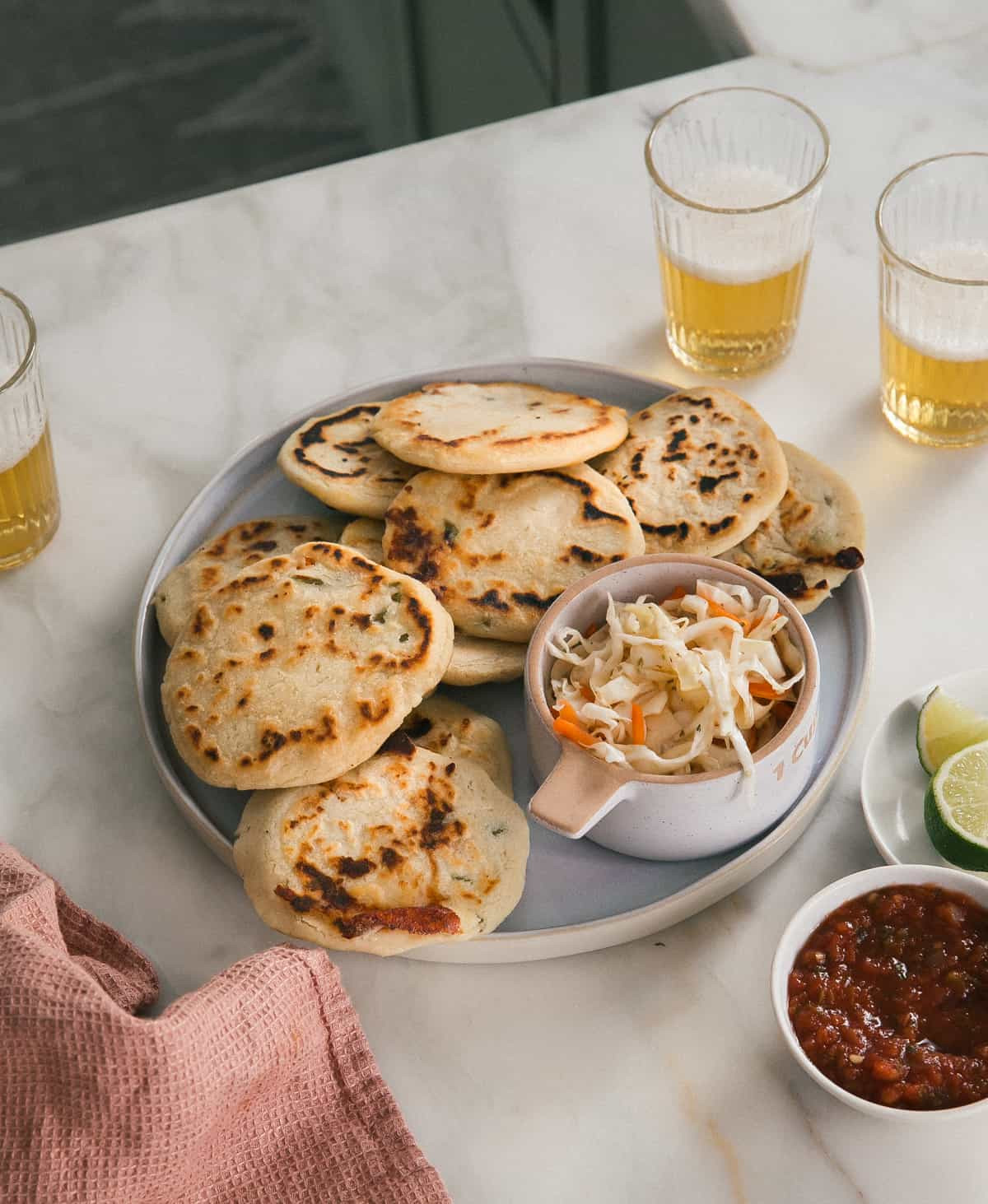 Pupusas on a plate surrounded by beer
Pupusas on a plate surrounded by beer
Enjoying pupusas with a cold beer makes for a perfect meal.
29. Connecting with the LGBTQ+ Community in Mexico
For LGBTQ+ travelers planning a trip to Mexico, it’s essential to connect with local resources and communities to ensure a safe and welcoming experience. Websites like gaymexico.net offer valuable information on LGBTQ+-friendly destinations, events, and businesses.
Additionally, organizations like the UCLA Williams Institute provide research and data on LGBTQ+ issues in Latin America, helping travelers stay informed about the social and legal landscape.
30. Pupusas: A Culinary Adventure Awaits
We encourage you to embark on a culinary adventure and discover the delicious world of pupusas. Whether you make them at home or try them at a local restaurant, we’re confident that you’ll fall in love with this authentic and flavorful dish. And as you explore the culinary delights of Mexico and Latin America, remember that gaymexico.net is your trusted resource for LGBTQ+ travel information and cultural insights.
FAQ About Pupusas
1. What exactly is a pupusa?
A pupusa is a thick flatbread from El Salvador, made with masa harina or rice flour and stuffed with fillings like cheese, beans, or pork. It’s typically served with curtido and salsa.
2. Is a pupusa Mexican food?
No, a pupusa is not Mexican food. It is a traditional dish from El Salvador.
3. What are the most popular pupusa fillings?
The most popular fillings include cheese (queso), refried beans (frijoles refritos), pork cracklings (chicharrón), and a mixture of all three (revuelta).
4. What is curtido?
Curtido is a tangy cabbage slaw that is traditionally served with pupusas. It’s made with shredded cabbage, carrots, onions, vinegar, oregano, and salt.
5. Can I make pupusas at home?
Yes, you can make pupusas at home. You’ll need masa harina, water, salt, and your choice of fillings.
6. Are pupusas gluten-free?
Pupusas made with masa harina are naturally gluten-free, but it’s important to make sure that your masa harina is not contaminated with gluten.
7. Can I freeze pupusas?
Yes, you can freeze pupusas. Assemble the pupusas, freeze them on a baking sheet, and then transfer them to a freezer bag.
8. What is the difference between tamale masa and pupusa masa?
Tamale masa typically contains lard or shortening, while pupusa masa does not.
9. Where can I find authentic pupusas in Los Angeles?
Some popular spots in Los Angeles include Los Chorros, Atlacatl Restaurant, and Pupuseria San Sivar.
10. What should I drink with pupusas?
Good drink pairings include horchata, agua frescas, Mexican beer, and Salvadorian coffee.
Ready to Explore More?
At gaymexico.net, we’re committed to providing you with comprehensive and up-to-date information about LGBTQ+ travel in Mexico. Whether you’re looking for the best gay-friendly hotels in Puerto Vallarta, tips for navigating Mexico City’s vibrant gay scene, or insights into the cultural nuances of different regions, we’ve got you covered.
Explore our travel guides: Discover the best destinations and hidden gems in Mexico.
Find LGBTQ+ friendly businesses: Browse our curated listings of hotels, bars, clubs, and restaurants that welcome the LGBTQ+ community.
Connect with the community: Join our forums and social media groups to connect with other LGBTQ+ travelers and locals.
Address: 3255 Wilshire Blvd, Los Angeles, CA 90010, United States
Phone: +1 (213) 380-2177
Website: gaymexico.net
